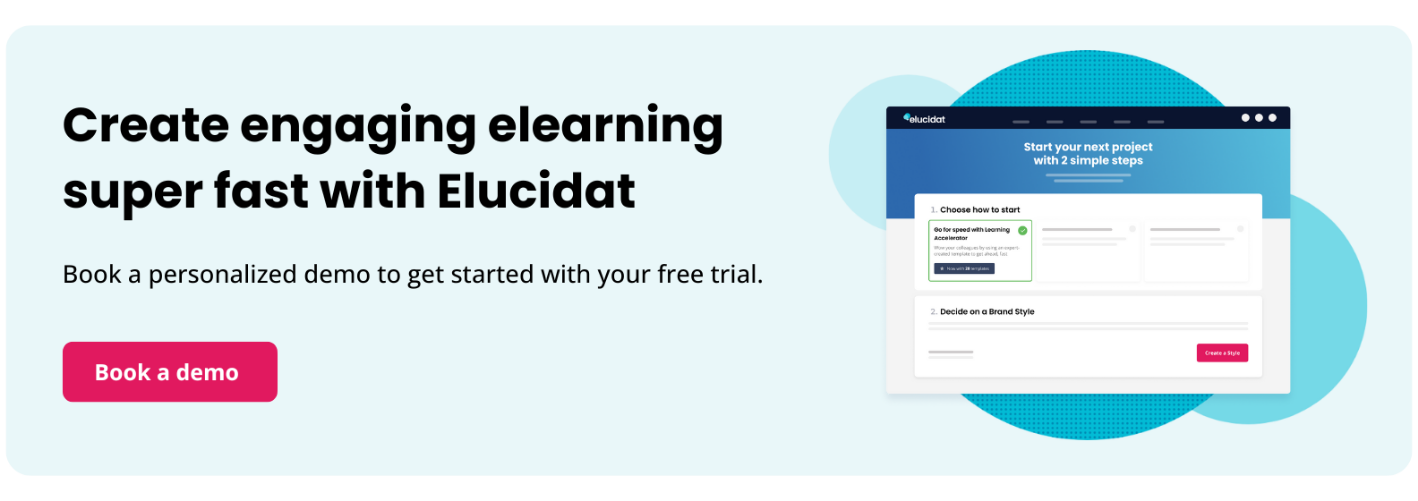How to conduct soft skills training for your employees
9 minute read
Does your organization overlook soft skills, such as communication, in favor of hard skills like qualifications and industry-specific expertise? This can be an easy trap to fall into. Fortunately, many companies are now recognizing the importance of soft skills in the workplace and having the right blend of hard and soft skills for building effective, collaborative and dynamic teams. After all, an employee’s soft skills can determine how they apply their hard skills and work with others… So how can you as an employer provide your employees with the opportunity for soft skill development? Read on for our guide to soft skills training, including:
- What is soft skills training?
- Benefits of soft skills training
- Best soft skills for improving employee performance
- How to conduct soft skills training
- Using elearning for soft skills training
- Planning your soft skills elearning
- Cost of soft skills training
- Elucidat & soft skills training
What is soft skills training?
Soft skills training is training that focuses on the development of abilities such as communication, teamwork and problem solving as opposed to hard skills which focus on an employee’s technical ability. Other soft skills include emotional intelligence, a positive attitude and taking the initiative. Developing soft skills in the workplace is often underappreciated. However, it’s just as important as hard skills.
Unlike hard skills, soft skills are not industry or role-specific, rather skills that relate to personality and behavior. While hard skills such as data analysis, reporting or mathematical ability, can be taught with relative ease, soft skills training can be more challenging as it involves teaching new behaviors and ways of thinking.
The effectiveness of soft skills training in the workplace can also be more difficult to measure as it is generally less quantitative. Creating an effective soft skills training development plan and choosing the best online training platform can be the difference between success and failure.
Benefits of soft skills training
Soft skills can be highly desirable for businesses and are important components of a resilient, empathetic and motivated workforce. The key benefits of soft skills courses and training include:
1. Improved teamwork and rapport
Developing important skills such as communication and teamwork can help to build stronger and more effective workplace relationships and boost collaboration, resulting in higher levels of team productivity.
2. Empathetic leadership
Professional soft skills are critical at every level, and that includes leadership. Leaders with emotional intelligence and great interpersonal skills are more likely to get the best out of their employees by understanding their needs and building valuable relationships.
3. Happier employees and better staff retention
Investing in employee soft skills training demonstrates that you care about their development and provides them with useful skills that can make them better at their job and more fulfilled. Developing important soft skills can also help to create a more pleasant working environment, further bolstering the opportunities for staff retention.
4. Better customer service and client satisfaction
Soft skills training teaches employees how to communicate effectively and tackle problems more confidently. Soft skills training in the workplace can also help to develop their listening and empathy skills which are key when dealing with customers or clients, especially if faced with a potentially complex problem.
5. Enhanced problem solving
Employees can benefit from enhanced problem-solving skills from soft skills training. It can help them to approach problems in new ways, communicate challenges more effectively and implement alternative solutions.
Best soft skills for developing employee performance
Not only does soft skills training make for happier and more fulfilled employees but it can also have a positive impact when it comes to employee performance. These are just some of the most desirable soft skills for improving employee performance:
Communication
Great communication is among the most important soft skills for professionals. Whether it’s day-to-day team communication, or interacting with clients or customers, having great communication skills are essential for working efficiently and effectively – and building rapport with those around you.

Teamwork
Teamwork is a critical skill for all members of teams, especially in a business environment. Soft skills training can help employees to understand their strengths and weaknesses within a team and learn how to best communicate with others for the best outcome.
Time management
For efficient operations and cost savings, good time management is important. Spending too much time on one task or neglecting another can lead to inefficiencies and disgruntled clients. Deploying soft skills course to teach employees how best to manage their time and juggle different tasks is a very useful skill for employees to master.
How to conduct soft skills training
Like with any learning and development program, auditing your current skills gap is a good place to start. To pinpoint opportunities for soft skill development, speak with employees at all levels of the organization to identify whether there are obvious areas of improvement and consult with managers to determine whether there are any common soft skills that come up in appraisals often, e.g. communication or organization.
The next step is to decide the format and delivery method of your soft skills training. Do you want to conduct face-to-face training, offer interactive online courses via an LMS, or offer a blended learning approach? The team at Elucidat have extensive experience with delivering impactful training at scale, using a wide range of formats, so if you’re not sure of the best approach for your employee soft skills training, speak to one of our learning experts.
If you decide on digital learning, the next step is to choose an authoring tool that offers everything you need to develop soft skills for professionals effectively. Depending on your experience with elearning authoring tools, budget, and complexity of your project, some types of soft skills courses may be a better fit than others, so be sure to take a demo of a few to find the best solution. You can see a full review of the best elearning authoring tools here.
Once you have selected your authoring tool, you can then go on to build out your content, using pre-built templates or building from scratch. Be sure to engage Subject Matter Experts from across your L&D and HR teams to ensure your content hits the mark. And, for the best results, choose interactive formats such as quizzes, branched scenarios and video to keep employees engaged.
Alongside digital soft skills courses, you could also consider one-on-one coaching sessions, workshops and peer mentoring. You can explore different types of blended learning here.

Using elearning for soft skills training
Corporate elearning can be a highly effective method for soft skills development. Not only does it allow employees to do the training little and often, but it also allows them to test their soft skills as they go with scenario-based training. Here are some of the key benefits of soft skills elearning:
1. Manageable and digestible learning
Soft skills aren’t something anyone can learn overnight, it is learned behavior developed over time through repetition and ongoing training. Creating a dedicated soft skills course allows employees to access it regularly, in bitesize chunks, from their laptop or smartphone. That way, it doesn’t interfere with their day-to-day work and is more likely to become a habit that sticks.
2. Innovative and engaging formats
Unlike an in-person talk or reading materials, elearning allows employees to engage in simulated scenarios, answer questions in real-time and put their soft skills to the test. It also enables them to receive instant feedback and analyze their performance to understand which skills they can improve further.
3. Learning by observation
Video is a useful format for teaching soft skills as it allows the learner to observe soft skills in real-life scenarios and translate them into everyday life. It encourages employees to immerse themselves into a situation and reflect upon how they would react.
If you’re looking for new ways to level-up your elearning soft-skills courses then try this certified course in engaging elearning design.
Planning your soft skills training
We’ve touched on some of the ways you can approach your soft skills training, and how this can benefit your organization. Now let’s break down how these methods might look.
1. Soft skills training modules
Elearning modules for soft skills training might include one or more of the following:
- Scenarios or case studies, that demonstrate the soft skills in practice and how these skills impact on people.
- Video drama that captures best (and worst!) practice, so learners can master the skills through observation.
- Interactive videos that set up a scenario with characters and ask learners to make a decision that taps into the soft skills. The learner can then see how this decision plays out for the characters.
- Social polls which ask your learners to answer a question and then compare their response to their peers. These questions can be used to explore the gray areas associated with soft skills when there’s not always a “right” or “wrong” way of applying them.
- Assessments placed at the end of a module to help consolidate learning and ensure learners are ready to apply their skills to real life.
- Microlearning, built as single elearning pages, to be accessed by learners on mobile devices as just-in-time performance support.
2. Soft skills training examples
Here are some examples of the above, so you can see these approaches in action:
- Bullying prevention training, with interactive scenarios
- People and performance management training, with social polls
- Sales skills microlearning, to be used as performance support
- Emotional support training, with interactive video
3. Soft skills training material
In addition to elearning modules, you can create a range of other training materials to support your learners, including:
- Fact sheets for learners to download and refer back to on-the-job, summarizing the component parts of the soft skills
- Workbooks, including exercises for learners to complete that will get them to apply their newly acquired skills
- Observation records for coaches and managers to complete, providing feedback on the learner’s performance and progress
4. Soft skills training programs
As we’ve mentioned, your soft skills training program could take a blended learning approach, pulling together a combination of the items above. How might this work?
Let’s use an example – you are training your salespeople to be able to demonstrate active listening in their customer conversations:
- You might use an elearning module to deliver the bulk of the information. It could explain what active listening is, list out the verbal and non-verbal skills involved, and show a video drama of these skills in practice. (You could also re-deliver this as refresher training later on.)
- You could then use classroom workshops to get learners to practice their active listening skills in a series of role plays. For example, the learners could get into pairs, be given a conversation topic and be assigned the roles of salesperson and customer. The “salesperson” will need to convey their active listening skills to the “customer”, they could do this by holding eye contact, and being able to recall the main points that the customer shared at the end. The pairs can then feed back to each other, with the support of a facilitator.
- You could deliver a digital checklist to learners, listing the verbal and non-verbal cues they should express in active listening. They can refer back to this before they enter their next real customer conversation.
- You could issue learners’ workbooks, providing space for them to reflect on how they performed in their customer conversations. These could include pages for coaches or managers to record their observations about that learner’s performance.
- You could send quarterly emails to your learners, reminding them of the key headlines. For instance, a simple message like, “Have you been truly listening to your customers? Remember, active listening is about being patient – about truly understanding, rather than just responding. Don’t interrupt your customer or change the trajectory of the conversation before they’re ready.” This will help refresh their memory and drive long-term behavioral change.
Cost of soft skills training
The cost of soft skills training will depend on the size and complexity of your project, as well as the delivery method you choose. If you need to create elearning content that’s scalable or if you need to adapt your training for global audiences, ensure your chosen authoring tool has built-in localization capabilities to save time and keep costs down.
Eluciat provides different pricing options for organizations of all sizes. Check out the different pricing plans here.
Elucidat and soft skills training
Elucidat is a great option for creating engaging and responsive soft skills training. With Elucidat, you can choose from a range of attractive pre-built templates, build customized branching scenarios and incorporate a variety of interaction types such as polls and gamification. It’s suitable for authors of all levels, and allows you to produce high-quality elearning, fast. We also have an outstanding support team who are on-hand to offer support and expert elearning advice.
Book a demo to get started with Elucidat today!






